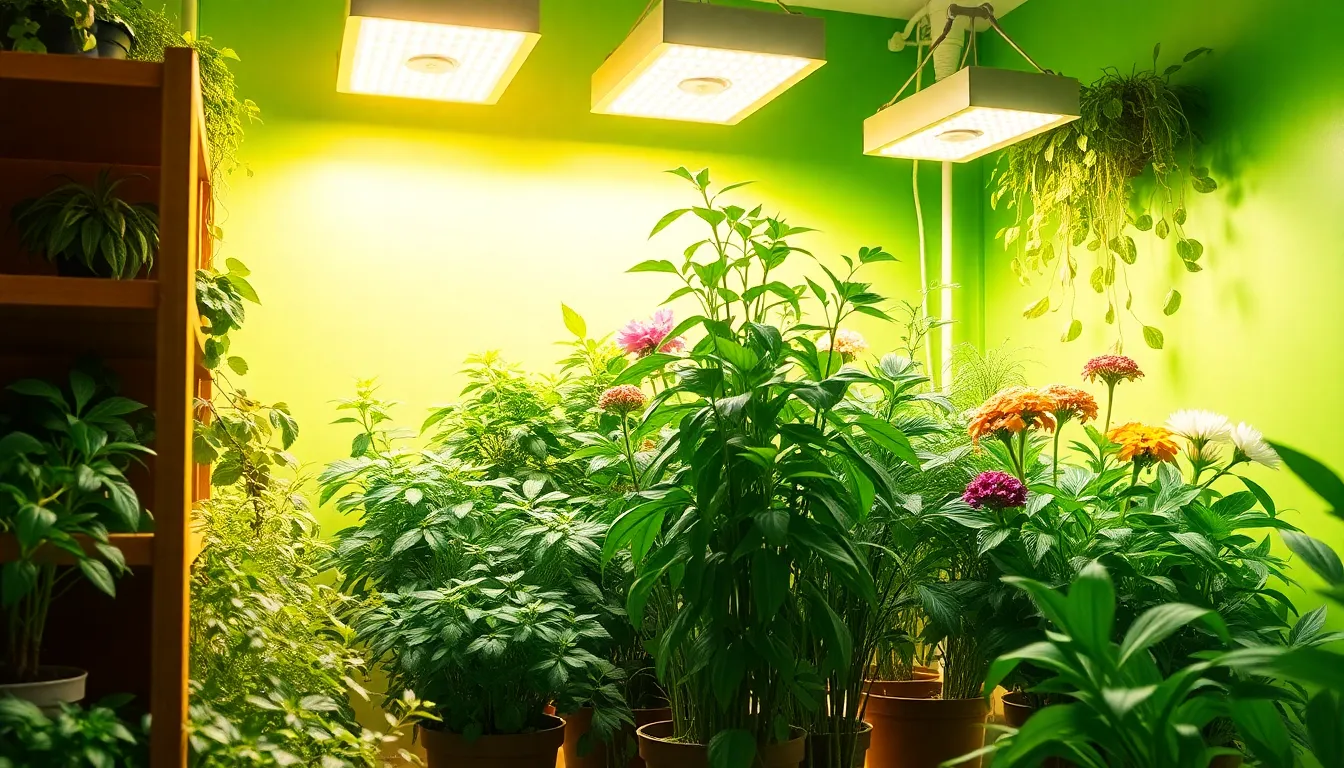Indoor gardening is more than just a trend; it’s a lifestyle choice that brings a touch of nature into homes. But let’s face it, not all of us have sun-soaked balconies or sprawling backyards. Enter grow lamps—the superheroes of indoor plant care. With these nifty devices, anyone can transform their living space into a lush green paradise, no matter how dim the lighting situation may be.
grow lamps for indoor plants
Grow lamps play a crucial role in indoor gardening, ensuring plants receive adequate light to thrive. They simulate sunlight, making it easier to create a flourishing indoor garden.
What Are Grow Lamps?
Grow lamps are artificial light sources specifically designed to support plant growth. These lamps provide wavelengths of light that plants utilize for photosynthesis, promoting healthy leaf development and flowering. Typically, grow lamps emit red and blue light, which cater to different growth stages of plants. These fixtures come in various forms, including bulbs, panels, and tubes, suiting diverse indoor environments and plant types.
Types of Grow Lamps
Various types of grow lamps exist, each serving unique needs. LED grow lamps stand out for their energy efficiency and long lifespan. Fluorescent grow lamps, commonly used by beginners, offer affordability and effective light coverage. High-intensity discharge (HID) lamps deliver intense light suitable for larger growing areas and specific plant types. Lastly, incandescent grow lamps provide minimal light and are less effective for serious indoor gardeners. Choosing the right type enhances plant growth and energy usage.
Benefits of Using Grow Lamps

Grow lamps offer numerous advantages for indoor gardening. By providing the correct light spectrum, these lamps enable plants to achieve optimal growth.
Enhanced Growth and Development
Grow lamps significantly enhance plant growth and development. They supply specific wavelengths essential for photosynthesis, leading to healthier foliage and robust flowering. Indoor plants rely on these artificial light sources to mimic sunlight, achieving accelerated growth rates. Research shows that plants under grow lights often exhibit increased biomass and improved overall health compared to those in low-light environments. The right intensity also prevents issues like leggy growth while promoting strong root systems. This stimulation contributes to a lush, vibrant indoor garden.
Year-Round Gardening
Year-round gardening becomes possible with the use of grow lamps. No matter the external weather conditions, indoor plants thrive under consistent light. Grow lamps eliminate seasonal limitations, allowing individuals to cultivate various species throughout the year. This flexibility ensures gardeners can enjoy fresh herbs, vegetables, and flowers during any season. Lighting schedules can be adjusted for different growth stages, providing further customization. Grow lamps thus transform indoor spaces into year-round lush environments, maximizing gardening potential.
Choosing the Right Grow Lamp
Selecting an appropriate grow lamp is vital for indoor gardening success. Various factors influence this decision.
Factors to Consider
Light intensity significantly affects plant growth. Different plants require distinct light levels to thrive. Size of the growing area also impacts lamp selection; larger spaces may necessitate high-intensity options. Heat output is another factor; some lamps generate excess heat, potentially harming sensitive plants. Budget considerations play a role as well; energy-efficient options may offer long-term savings despite higher upfront costs. Lastly, lamp lifespan should factor into the decision; longer-lasting bulbs reduce replacement frequency and maintenance efforts.
Recommended Wattage and Spectrum
Recommended wattage varies according to plant types and their light needs. Typically, 20-30 watts per square foot suits most indoor plants. Those requiring more light, such as tomatoes or peppers, might benefit from higher wattage. Spectrum preferences depend on plant growth stages; blue light promotes vegetative growth, while red light encourages flowering. Full-spectrum grow lights provide a balanced approach, supporting all growth phases. Following these guidelines ensures optimal lighting conditions for diverse indoor plants, enhancing their health and vitality.
Best Practices for Using Grow Lamps
Effective use of grow lamps enhances the growth of indoor plants. Practicing proper techniques maximizes their benefits.
Placement and Distance
Positioning grow lamps correctly significantly impacts plant health. Place lights 12 to 24 inches above the plants for optimal exposure. Adjustments depend on the type of lamp; LED options require less distance compared to HID lamps. Move the grow lamp closer if plants exhibit signs of stretching or leaning. Monitor plant responses, as this indicates light intensity is either insufficient or excessive. Keeping the light at the right distance fosters balanced growth and prevents leaf burn.
Timer Usage
Utilizing a timer simplifies the management of light exposure. Set timers to provide 12 to 16 hours of light daily, mimicking natural day lengths. Consistent timing ensures plants receive adequate rest during the dark cycle. Avoid disruptions to the light schedule, as these can stress plants. Choose programmable timers for convenience and accuracy, enhancing overall plant health. Proper lighting routines with timers support robust growth and flowering phases effectively.
Conclusion
Grow lamps are essential tools for anyone looking to thrive in indoor gardening. They provide the necessary light spectrum that plants crave for healthy growth and development. By investing in the right type of grow lamp and following best practices, indoor gardeners can create a vibrant green sanctuary in their homes.
With the ability to cultivate a variety of plants year-round, these lamps not only enhance the aesthetic appeal of living spaces but also promote a sustainable lifestyle. Embracing grow lamps means embracing the joy of nurturing plants, regardless of weather conditions outside. As indoor gardening continues to gain popularity, grow lamps will remain a key component in transforming indoor spaces into flourishing ecosystems.

